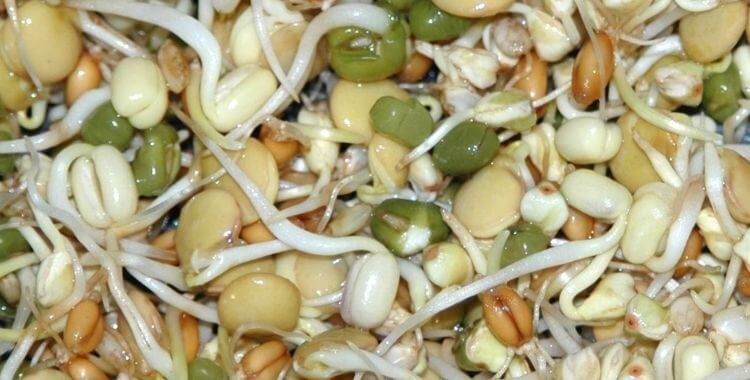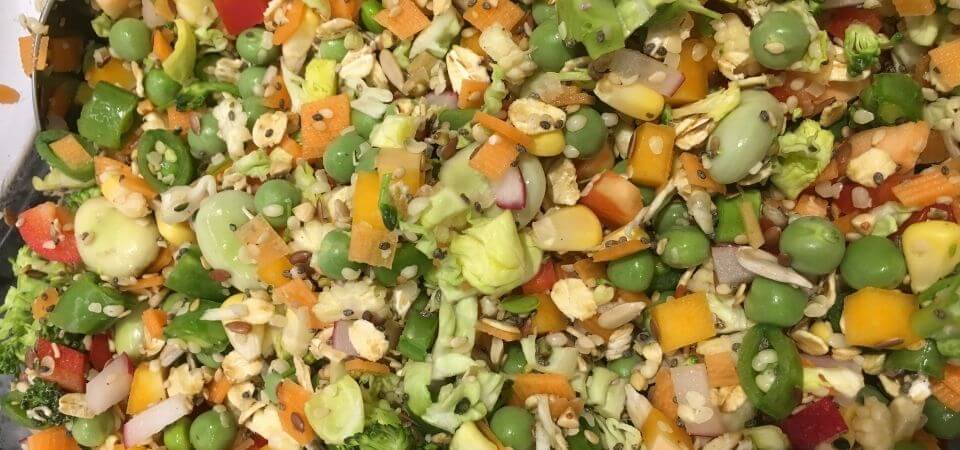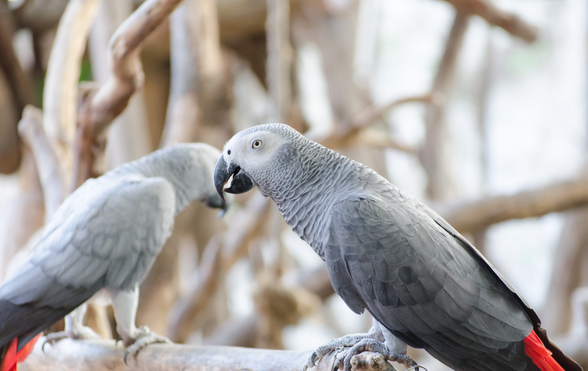Your African grey should be eating fresh vegetables and fruit, along with pellets or seeds depending on what your bird will accept. You can home cook for your bird to make it more fun.
Is your parrot insured? Get a quote for up to £5,000 of vet fee cover, death and theft cover | We’ve been insuring exotic pets since 1996 | Check out our customer reviews on Feefo.
Diet categories | What to feed African greys‘ | Vegetables | Fruit | Flowers | Outside produce | Nuts | Pellets | Seeds | Animal protein | Sprouting and soaking seed | How much food? | How often to feed | Regurgitating food | Food recipes
Diet categories
For parrot species, four specialized diet categories have evolved, granivory (eating grains and seeds, nectarivory (eating nectar) frugivory (eating fruit) and palinivory (eating pollen).
For some parrots, we consider a fifth and generalist category, omnivory, which is one that combines one or more of the four specialized plant-food categories with animal protein. However controversy exists around the provision of animal protein.

What to feed African greys’
The food choice for all captive birds is now enormous.
Pellets, seeds, grains, sprouts, fruits, vegetables, nuts, flowers, weeds and supplements.
Your first choice is whether seeds or pellets make up the bulk of the diet. Or whether you adopt a new trend which is to use mash and fresh food almost exclusively.
Seeds not pellets are what birds in the wild would eat. But in captivity seeds are lacking in micro-nutrients and should not be used exclusively for your parrot’s diet, as this will lead to poor health.
Neither seeds nor pellets contain enough Vitamin A. For this you need green vegetables and orange fruits.
Whether you offer pellets, seeds or chop as the principal part of the diet, your bird needs fresh produce.
A healthy bird that has been eating correctly will have bright eyes, shiny plumage and an upright stance.
Learn more about seeds and pellets here.
What vegetables can African greys’ eat?
Most vegetables and salad are suitable for greys’. Some providers will avoid mushrooms, garlic and onions; others use them to no ill effect. Their use is controversial.
You can feed celery, spinach, asparagus, cauliflower, corn, spinach, Brussel sprouts, kale, pumpkin, potatoes, collard greens, peas, carrots, cabbage, mustard greens, chillies, yams, and plantains.
Potato and tomato leaves are not suitable. Acorns are another arguing point however my aviary birds enjoy them.
What fruit can African greys’ eat?
You can serve any fruits available. Bananas, blueberries, strawberries, pineapple, watermelon, blackberries, cherries, grapes, kiwi, mango, orange, plums, pomegranate, pawpaw, passion fruit, raspberries, peach, banana peel, pears, raisins, dates, apples, papaya, melon, apricots etc. I have observed that my greys’ prefer tropical fruits to our fruit.
I would wash fruit from an unknown source.
I should note that current views consider commercially grown fruit contains too much sucrose. However, fruit are relished by Grey parrots. Their natural wild food is palm oil fruit. That would be too rich for captive birds except as a rare treat.
What flowers can African greys’ eat?
Greys’ love flowers and most are suitable. Those of us who make salads for our greys’ will use nasturtium, roses and pansies as edible decorations. Most popular with my flock are roses, marigolds and sunflowers which do have food value.
Some flowers are poisonous: Shamrock, holly, poinsettia, datura, laburnum, ivy, mistletoe, daffodils and lilies. A well-fed active Grey won’t generally touch poisonous plants. Although I would avoid having them in the home.
Produce collected out of doors
Some carers cultivate weeds for their flocks. Dandelions for example. Every part of the dandelion from flower to root is a valuable food source.
Chickweed are relished by breeding hens. You can also feed dock leaves, hawthorn berries, cotoneaster berries, milk thistle and similar plants, fir cones and branches.
An excellent addition to a Grey’s diet will also be items like wheat grass, lucerne, alfalfa or parsley that you can grow in pots outside the back door or on the balcony.
It’s sensible to wash produce gathered out of doors in a mild disinfectant in case of contamination.
What nuts can African greys’ eat?
African greys’ love nuts. Any and every variety, shelled or opened. They can eat cashews, brazil nuts, walnuts, almonds, pine nuts, macadamias, pecans, hazelnuts, shelled peanuts and pistachios.
Use them sparingly, never more than a few per day, for treats or for training.
The amount of nuts you give depends both on the individual and how much exercise she gets. A busy Grey flying round aviary or house and playing a lot can consume more nuts than a caged bird who doesn’t move much.
In training, breaking the nut up into slivers means that you can ask for more repetitions for any behaviour.
I’d expect an average training session to last up to five minutes and rewards would be three or four slivers of nuts. Pine nuts are valuable as training treats.
Coconuts are generally too hard for a grey’s beak, however empty shells make excellent foraging items.
Parrots and pellets
Pellets which are a formulated diet are considered a better choice for many than seeds.
Pretty Bird produces a pellet exclusively for African greys’ and Harrisons organic pellets are also suitable for greys’.
My greys’ cannot be persuaded to eat Pretty Bird although a colleague’s Grey, Monty thrives upon them.
It is generally possible to convert a seed eater to a pellet eater however it’s much easier to wean a young parrot onto pellets.
What seeds can parrots eat?
Parrots can eat safflower seed, sunflower seed, linseed and a range of other seeds. However, as mentioned, seeds lack micro-nutrients, and shouldn’t form a major part of the diet.
Can African greys’ eat meat and animal protein?
It is controversial whether parrots should be fed animal protein
Wild parrots are presumed to eat insects and grubs both from chewing bark and fruits. My greys’ when young were once offered a cooked chicken drumstick flesh removed, but no longer showed interest when they were mature.
I asked Alan Jones a senior UK vet, now retired, who told me:
“If you are asking about greys’, yes, certainly they are omnivorous. The Americans have an expression ‘facultative omnivores’ applied to most parrots, meaning that they will eat whatever is available at the time. Certainly, in captivity African grey parrots and other parrots will eat cooked egg, cooked chicken and fish, and cheese. In the wild, parrots will take carrion, fish, grubs and caterpillars, especially when feeding chicks”. Quote obtained December 2020.
I have listened to Alan’s advice in person and from his books and lectures for over twenty years and continue to do so.
Many carers believe animal protein should never be fed. You must make up your mind. Some of us feed eggs. I do myself occasionally provide a hard-boiled egg or a vegetable omelette which I share with the greys’. Some versions of birdy bread contain eggs.

Sprouting seeds and soaking seeds
A valuable addition to a Grey’s diet, is sprouts, seeds or grains. Both seed and pellet advocates agree the sprouts are beneficial to every parrot species.
Sunflower seeds which are frowned upon as being too full of fat, shed this when sprouted and contain valuable enzymes.
Sprouting seeds or grains isn’t complicated:
- You soak the seeds for 24 hours. Then rinse and place in one of the many types of sprouter available. A Kilner jar with a pierced lid will sprout equally well.
- Keep the jar tilted and rinse twice a day, letting the sprouter drain.
- Keep it in a warm place out of direct sunlight and use when the sprouts have a little tail. This takes two or more days.
- As the sprouts can develop mould keep well rinsed and clean, and never use if there’s any odour.
You can also sprout seeds like radishes, broccoli or beans to add to your own salads.
Drinking water for African greys’
Fresh water is essential all the times, so should be changed at least twice a day. Whether you use tap or spring water is a personal choice.
Owners have given anecdotal evidence that a few drops of cider vinegar have helped older birds with arthritis.
How much should you feed an African grey?
My regime is 40% seeds and pellets and 60% fresh food. Which includes a lot of nuts, especially for the active macaws.
I am aware that much current opinion decides 60% should be pellets with 10% seeds on top.
In terms of amount, you should feed around 10% of your bird’s body weight a day.
So a bird weighing 450 grams would receive around 45 grams of food.
How often should I feed my African grey?
Captive parrots are generally fed two or three times a day. How you choose your bird’s mealtimes is a personal decision depending on your lifestyle.
I am an advocate of two meals a day. The breakfast bowl should be removed after thirty minutes with no food left except overnight. After a busy day your Grey will be ready for his supper.
Following this routine means your bird will be keen for his training sessions. He’ll also eat well, and while the food is fresh.
Try keeping branches and chewable toys in the cage, instead of food, which you should be doing anyway, for mental stimulation.
Lactose intolerance
A parrot eating a food with too much lactose in it like ice cream or rich cheese will have a runny diarrhoea.
There are no milk trees in the rain forest nor do parrots breast feed. So, they have never evolved to digest lactose. That said, many parrots appear to love yoghurt or the occasional small piece of cheese. So, the answer would be to avoid products with lactose for complete security.
Calcium and vitamin supplements for African grey parrots
Greys’ can suffer from calcium deficiency more easily than other species, a lack of which can cause seizures, possibly feather plucking and poor health.
My vet has never advised supplements but advocates calcium rich foods such as kale, water-grass, cress, almonds and carrots.
When pellets form the main portion of the diet, supplements should not be given. If you are anxious than your avian vet should be asked for advice. You can find a vet here.
Why is my African grey regurgitating food?
Either because he or she wishes to feed you as their fledgling or it is a sexually active response from a parrot who fancies you as her mate. Ignore the practice, change the subject and never punish normal behaviour.
Cooking for parrots
It isn’t necessary but it’s so much fun. Most parrot owners I know do it – whether or not they’re gourmet cooks.
African grey food recipes
Chop and Mash
Making chop and freezing it has become a popular way to feed parrots. The idea of chop is that you cook various healthy grains, add vegetables, fruit, nuts, herbs and spices and freeze sufficient quantities in individual sachets for several weeks or even months.
Chop recipes abound they’re similar to birdie bread. Here is a simple one. They seem fussy at first but with practice they become easy and are great fun.
Bean and vegetable mix for freezing
- Mustard seeds: 2 tablespoons
- Cumin: 1 teaspoon
- Garlic: 2-4 cloves
- Ginger: 1 cm chopped root or one teaspoon
- Chilli powder: 1 teaspoon
- Selection of cooked beans: 250-400 grams per bean
- Chickpeas
- Black beans
- Mung beans
If you have no time to soak and cook beans you can use tinned, drained beans.
Vegetables
Use 500-1 kg of whatever is in season. Try to include carrots, cooked sweet potato, peas, sweet corn off the cob and green leafy vegetables.
Cooking
Pop the mustard seeds in a tablespoon of oil. Add the other spices and cook gently for a few minutes until combined.
Add the beans and fresh vegetables. Only let it warm through, don’t cook the mixture. Top with cinnamon, poppy or sesame seeds. Let it cool and freeze in meal size portions.
This recipe will provide between 2/3 kg of chop. You can use smaller quantities for a single bird. With my flock, the greys’, goffins and macaws enjoy this recipe.
Birdy Bread
Parrot cooks have their favourite, here’s mine. It’s not for daily use as it’s too rich and calorific. So only feed it as an occasional treat. It also contains eggs, so do not feed if you avoid animal products.
- Organic flour spelt, kamut or rye: 250 grams
- Rapeseed oil: 4 tablespoons
- Coconut sugar: 4 tablespoons
- Apple sauce: 200 ml
- Eggs: 3
- Cinnamon: 1 teaspoon
- Topping: Poppy seeds or flaked almonds
I mix the flour, oil and sugar till smooth then add the eggs, apple sauce and cinnamon. I bake in a bread tin for 35 minutes at 180 C.
This recipe is not ideal for birds but has the advantage that people can enjoy it too. You can also add 150 grams of grated beetroot into the mix if you are feeling adventurous.
Dot’s mash
To make a mash you soak seeds and legumes for 12/24 hours and allow them to sprout. Then cook those along with various grains. Afterwards add finely chopped fruit and vegetables, cooked or raw, and freeze in individual portions.
When serving an unfrozen portion, you might sprinkle something like spirulina, sesame seeds or flaxseed oil.
- 100 grams cooked grains (brown rice or buckwheat)
- 100 grams cooked quinoa
- 100 grams cooked beans
- Lightly steamed sweet potato or an organic potato
- 1.5 kg of fresh vegetables
Fresh vegetables include carrots, cabbage, broccoli, celery, spinach, pumpkin, courgettes, green and red peppers, and corn cobs – whatever is in season.
I used to chop fresh vegetables but now use the blender so that the macaws cannot pick out their favourites and throw the rest on the aviary floor.
When vegetables are in short supply, I use frozen, and I regularly use frozen peas and tinned sweetcorn. Herbs and spices vary for each mix – cinnamon, turmeric, star anise, coriander, etc.
Parrot insists on sharing your food
You’ve been told countless times that fried food, crisps, chips, pizza, tea, coffee, alcohol, chocolate and avocado are forbidden and can even be fatal for birds.
So, you have two choices: first – you never let your bird out of its cage when humans are eating.
A hard one because my pet birds enjoy actively socialising with visitors who may be eating and drinking unsuitable items.
Second – only serve and eat healthy foods. Since we eat mainly vegetarian, this is easier than it seems at first. And good for our health because fried food, fats and too much sugar give me indigestion.
Artha as a young bird had the habit of swooping down to the family tea table and swooping off clutching a LARGE slice of cake. She was caught and allowed a few crumbs.
Conclusion
When it comes to diet it’s important to note that fashions and fads change Twenty years ago a parrot manual I consulted recommended coffee and a roll for the grey’s breakfast.
These days vets, researchers, experts, breeders, zoo owners and hobby owners do not have a 100% agreement on parrot diet. So, the conscientious carer of a companion grey has to make her own choices.
So with this in mind, have we reached a conclusion as to the best nutrition for African greys’? Sadly, the question reverts to how long is a piece of string?
Is your parrot insured? Get a quote for up to £5,000 of vet fee cover, death and theft cover | We’ve been insuring exotic pets since 1996 | Check out our customer reviews on Feefo.
Own a cat or dog? Get pet insurance that covers up to £12,000 for dogs and £9,000 for cats in vet fees every year, including dental for illness and accidents with British Pet Insurance.

